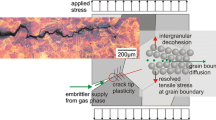Abstract
Highly residually stressed polycrystalline aluminium oxides were found to exhibit residual stress relaxation, as evidenced by changes in load-bearing ability, at temperatures as low as about 850° C. This temperature is much too low for such relaxation to occur by dislocation, Nabarro—Herring or Coble creep. Irreversible changes in specimen dimension coupled with SEM-fractography revealed that the stress relaxation resulted from creep by intergranular cavitation and crack propagation. In one aluminium oxide, such cavitation and crack propagation appeared to take place in a stable mode along a viscous glassy grain boundary phase. In high-purity fine-grained aluminium oxide, crack propagation occurred in a frequently totally catastrophic and highly unstable manner. This latter material was also observed to exhibit spontaneous fatigue during isothermal anneal. Implications of the findings of this study for the use of thermal anneals to promote residual stress relaxation in structural ceramic materials are discussed.
Similar content being viewed by others
References
A. G. Cockbain,Proc. Brit. Ceram. Soc. 25 (1975) 253.
A. Yu Malinin, V. S. Papkov, V. D. Chumak andA. P. Vidanov,Iz. Akad. Nank SSSR Ser. Fiz. 37 (1973) 2367.
H. P. Kirchner, “Strengthening of Ceramics” (Marcel Dekker, Inc., New York, 1979).
F. I. Baratta,Bull. Amer. Ceram. Soc. 57 (1978) 806.
R. C. Pohanka, R. W. Rice andB. E. Walker Jr,J. Amer. Ceram. Soc. 59 (1976) 71.
W. Kerstan,Sprechsaal 113 (1980) 54.
R. Gardon andO. S. Narayanaswamy,J. Amer. Ceram. Soc. 53 (1970) 380.
A. R. Cooper andD. A. Krohn,ibid. 52 (1969)665.
A. J. Durelli andW. F. Riley, “Introduction to Photomechanics” (Prentice-Hall, Englewood Cliffs, NJ, 1965).
B. D. Cullity, “Elements of X-Ray Diffraction”, (Addison-Wesley Pub. Co., Reading Massachusetts, 1956).
P. J. Noronha andJ. J. Wert,J. Testing Eval. 3 (1975) 147.
L. Grabner,J. Appl. Phys. 49 (1978) 580.
C. P. Chen, private communication (1980).
E. A. Fisher, in “Proceedings of the Workshop, Non-destructive Evaluation of Residual Stress”, San Antonio, Texas, August 1975 (NTIAC Publications, San Antonio, Texas, 1975) p. 125.
C. C. Hsiao, “Fracture 1977” Vol. 3 (ICF4, Waterloo, Canada, June 1977).
D. P. H. Hasselman, personal observation.
F. R. N. Nabarro, “Report on a Conference on the Strength of Solids”, (Physics Society, London 1948) p. 75.
C. Herring,J. Appl. Phys. 21 (1950) 437.
R. L. Coble,ibid. 34 (1963) 1679.
D. A. Krohn, P. A. Urick, D. P. H. Hasselman andT. G. Langdon,ibid. 45 (1974) 3729.
A. Venkateswaran andD. P. H. Hasselman,J. Mater. Sci. 16 (1981) 1627.
J. Weertman,Trans. ASM 62 (1969) 502.
J. F. Lynch, C. G. Ruderer andW. H. Duckworth, “Engineering Properties of Selected Ceramic Materials” (American Ceramic Society Inc., 1966).
R. J. Fields andM. F. Ashby,Phil. Mag. 33 (1976) 33.
D. R. Clarke, in Materials Science Research, Vol. 14, Surfaces and Interfaces in Ceramic and Ceramic Metal Systems, edited by J. A. Pask and A. G. Evans (Plenum Press, New York, 1981) p. 307.
D. P. H. Hasselman,J. Amer. Ceram. Soc. 52 (1969) 600.
A. G. Evans,Acta. Met. 28 (1980) 1155.
K. Kromp andR. F. Pabst,Met. Sci. 15 (1981) 125.
T. J. Chuang andJ. R. Rice,Acta Met. 21 (1973) 1625.
A. G. Evans, M. Linzer andL. R. Russell,Mater. Sci. Eng. 15 (1974) 253.
“Fracture Mechanics of Ceramics” Vols. 1, 2, 3 and 4, edited by R. C. Bradt, F. F. Lange and D. P. H. Hasselman (Plenum Press, New York, 1974, 1978).
T. G. Langdon andF. A. Mohamed,J. Mater. Sci. 13 (1978) 473.
Author information
Authors and Affiliations
Rights and permissions
About this article
Cite this article
Tree, Y., Venkateswaran, A. & Hasselman, D.P.H. Observations on the fracture and deformation behaviour during annealing of residually stressed polycrystalline aluminium oxides. J Mater Sci 18, 2135–2148 (1983). https://doi.org/10.1007/BF00555008
Received:
Accepted:
Issue Date:
DOI: https://doi.org/10.1007/BF00555008




